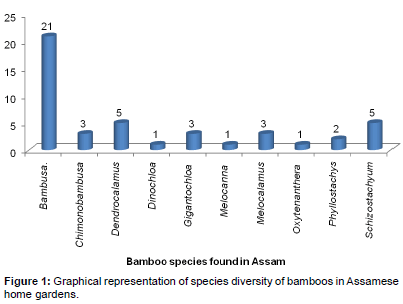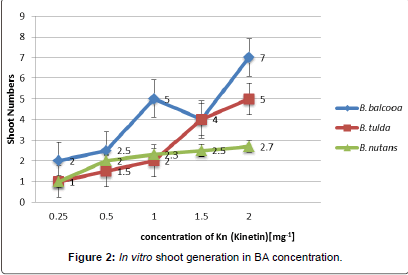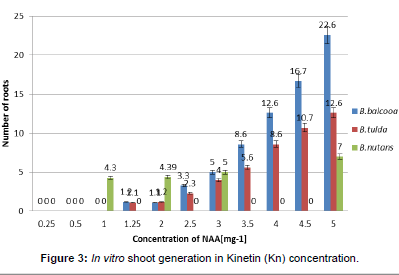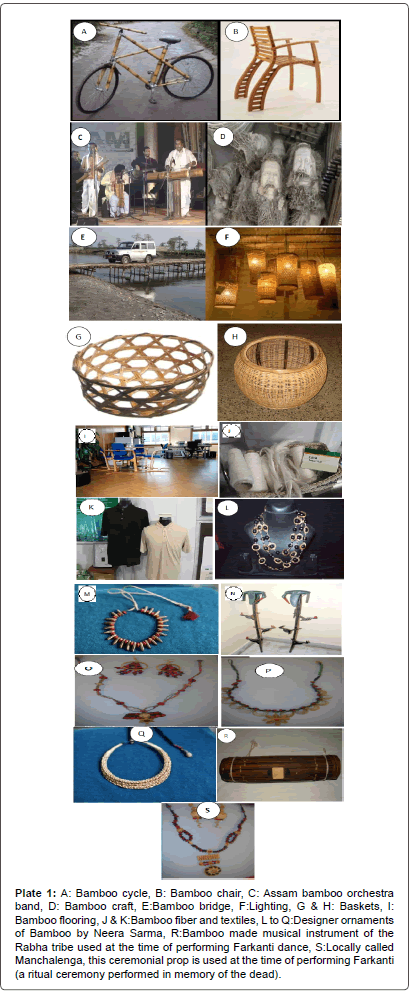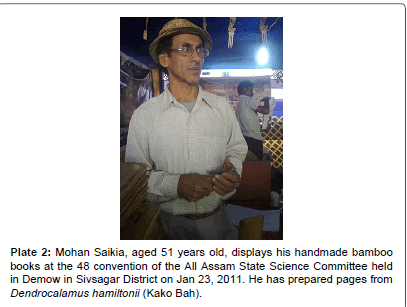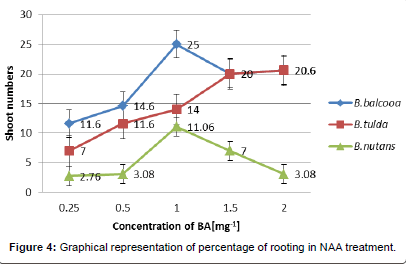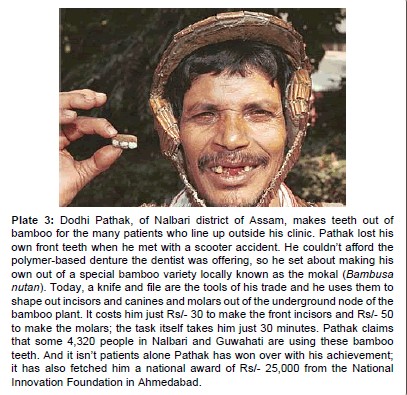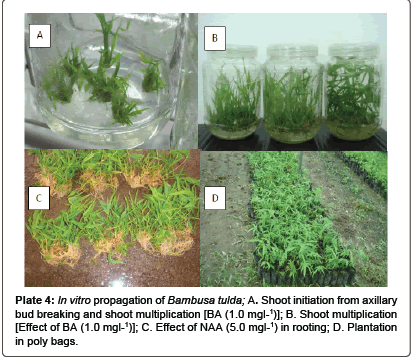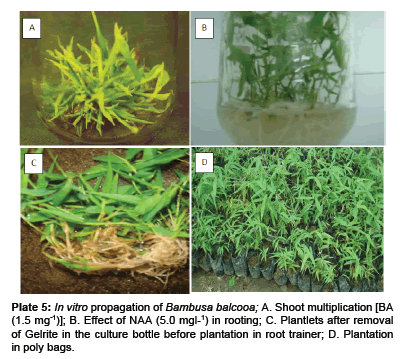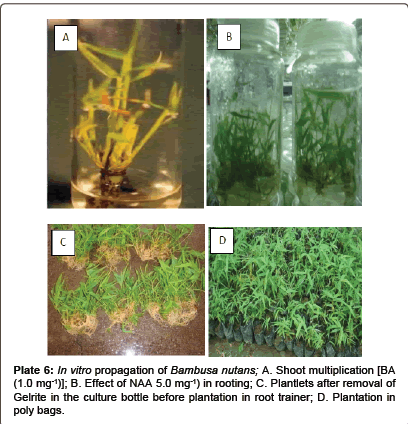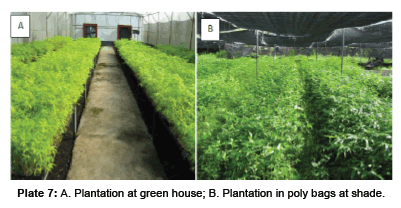Research Article Open Access
Diversity, Uses and In vitro Propagation of Different Bamboos of Sonitpur District, Assam
Pratibha Sharma1*, Saikia P2and Sarma KP11Department of Environmental Sciences, Tezpur University, Napaam-781028, Tezpur, Assam, India
2Centre for Environmental Sciences, Central University of Jharkhand, Brambe-835205, Ranchi, Jharkhand, India
- Corresponding Author:
- Pratibha Sharma
Department of Environmental Sciences
Tezpur University, Napaam-781028
Tezpur, Assam, India
Tel: +91- 9864159888
E-mail: prativasarma@rediffmail.com
Received October 16, 2015; Accepted April 23, 2016; Published April 30, 2016
Citation: Sharma P, Saikia P, Sarma KP (2016) Diversity, Uses and In vitro Propagation of Different Bamboos of Sonitpur District, Assam. J Ecosys Ecograph 6:184. doi:10.4172/2157-7625.1000184
Copyright: © 2016 Sharma P, et al. This is an open-access article distributed under the terms of the Creative Commons Attribution License, which permits unrestricted use, distribution, and reproduction in any medium, provided the original author and source are credited.
Visit for more related articles at Journal of Ecosystem & Ecography
Abstract
Bamboos are the tallest and largest member of the grass family and widely distributed in India and abundantly occur in northeast region. A few species are also found scattered in other parts of the country both in the hills and the plains. Bamboos play an important role in the day to day lives of common people of Assam and become an integral part of the cultural, social and economic traditions of the State. Besides, it is an essential component of forest ecosystem and commonly found in the traditional home gardens of Assam. Study was carried out in 62 randomly selected home gardens of Sonitpur district of Assam. The maintenance of bamboo diversity in home gardens fulfills the household necessity and also contributes to the rural economy. The commonly found bamboos are B. tulda, B. balcooa, B. pallida, B. nutans, B. bambos, Dendrocalamus strictus, D. hamiltonii, Melocanna baccifera etc. Home garden based bamboos have also great demand as a construction materials, fencing, fodder and also as a source of fiber for paper industry. Tissue culture technique is also applied in three selected Bamboos for large scale production of plantation stocks for commercial cultivation. Rural employment can be generated by proper cultivation and management of bamboos in traditional home gardens thereby helps in conservation of bamboo diversity without much care and effort.
Keywords
Home gardens; Tissue culture; Bamboo diversity; Conservation; Rural employment
Bamboos are an integral part in the traditional home gardens of Assam, Northeast India. In India, bamboo is traditionally considered as the poor man wood, and labeled as Green Gold and being considered as a major export item for the global market. Bamboo is one of the fastest growing plants on earth and may grow up to 1.2 m per day. It is an environment friendly plant as its roots can reduce soil erosion up to 75%, generates more oxygen than equivalent strands of trees, lowers light intensity, protects against ultraviolet rays and is an important atmospheric and soil purifier. It is a multipurpose and high yielding renewable resource with great economic value. The Northeastern region of India is one of the richest reservoirs of genetic diversity with its own unique biodiversity, habitats and ecosystems. People in the region are using bamboo for various purposes from time immemorial, right from bridges over mighty rivers to sitting mats, safety items against rain, carry bags, writing pens, household utensils, cradle, walking stick for old man and finally bier to carry the dead body. Bamboos are a diverse and primitive group of perennial plants of the family Poaceae. They are cosmopolitan in distribution, particularly distributed in the Asia- Pacific region. In India, it is found all over the country, particularly in the tropical, sub-tropical and temperate regions where the annual rainfall ranges between 1,200 mm to 4,000 mm and the temperature varies between 16°C and 38°C. There are ca. 2000 species are found worldwide belonging to over 70genera and cover an area of 14 million hectare worldwide [1]. About 80% of the species are confined to China, India and Myanmar.
India is very rich in Bamboo diversity. There are 126 Indigenous and exotic species under 23 genera, which are found naturally and under cultivation or both [2,3]. Northeast India supports about 50% of the total genetic resources of Bamboo [4] followed by Peninsular India mainly the eastern and western ghats (23%). Northwestern India, Indo-Gangetic Plains and Andaman and Nicobar islands account for the remaining diversity [5]. More than 50% of the bamboos occurring in India are endemic and roughly, 19 species are rare and threatened. Clump forming bamboo constitute over 67% of the total growing stock, of which Dendrocalamus strictus account for 45%, Bambusa bamboos 13%, D. hamiltonii 7%, B. tulda 5%, B. pallida 4% and all other species account in total for 6%. Melocana baccifera, a non-clump forming bamboo, account for 20% of the growing stock and is found only in the northeastern states. India is the third richest country in bamboo resources next to China (300 species) and Japan (237 species). Northeast India falls under the Indo-Burma region which is one of the 8 hottest biodiversity hotspots with more than 7,000 endemic plants [6]. 65% of bamboo in the country and 20% of the World’s bamboo grow in this region [7]. This region is considered as the “Bamboo Paradise of India” and is a treasure house of bamboos. Bamboo accounts for around 12.8% of the total forest cover of India [8]. Northeast India harbors more than 54 species of bamboos out of 128 reported from India [4,9] of which 35 species are endemic to this region [7]. This makes their conservation even more essential and imperative.
Home gardens are traditional agroforestry systems characterized by the complexity of their structure and multiple functions [10]. It is a traditional land use practice around a homestead where several plant species are maintained by members of the household and their products are intended primarily for household and their products are intended primarily for household consumption [11]. Home garden is generally accepted to be an economically efficient, ecologically sound and biologically sustainable agroforestry system [12]. Bamboos form an integral constituent of the home gardens in Assam [13]. Bamboo grove is a separate zone within the home garden or in the adjoining areas where bamboo is grown either in pure stands or mixed with other plants. Bamboo is one of the more important components of the home gardens, which provides the villagers with a wide range of goods and services [14]. In the present research, the diversity of cultivated bamboos in home gardens of Sonitpur District (Assam) and the uses of bamboos in day to day life of Assamese people was studied. Also, tissue culture technique is applied in selected bamboos for commercial production of plantation stocks.
Materials and Methods
Study sites
Sonitpur district is spread over an area of 5324 sq. kms on north bank of Brahmaputra River. In terms of area it is the second largest district of Assam after Karbi Anglong district. The district lies between 26°30’N and 27°01’N latitude and between 92°16’E and 93°43’E longitude located between mighty Brahmaputra River and Himalayan foothills of Arunachal Pradesh. The district covers largely plain with some hilly pockets.
Sampling techniques
Study on diversity of bamboos was carried out in 62 randomly selected home gardens of Sonitpur district, Assam. Diversity of bamboos was studied by quadrate method in randomly selected home gardens. Random quadrates of 10 m x 10 m had been laid in the representative areas of the home gardens. Uses of bamboos were studied by interview based field work with local people, owners of homegarden and craft shop, and the traders of the area and also by literature, modern market study (Figure 1). For tissue culture study, a standard protocol was maintained by culturing the explants in standard Media [15].
Culture establishment
Single juvenile shoots with axillary bud of selected Bamboo species (B. balcooa, B. tulda and B. nutans) (1.5 to 2.0 cm in length) were collected from a natural bamboo stands different areas of Sonitpur district. The nodes containing the axillary buds were used as the source material for micro propagation. Clumps of donor bamboos were about 10-20 years old. Prior to surface sterilization, leaf sheath of axillary bud were removed and sized. Explants were surface sterilized with 70 percent ethanol soaked cotton by swabbing and then disinfected with 0.1 percent HgCl2 solution for 5 minutes followed by 3-4 times washing with sterilized distilled water to remove the traces of steriliant. The disinfected explants were dipped in 5 percent (v/v) Tween 20 solution (4-5 drops; Reckitt Benckiser, Gurgaon, India) for 15 minutes and then washed thoroughly under running tape water for 30 min. The explants were then rinsed with sterile distilled water. Pretreatment of the explants were carried out with aqueous solution of 0.5 percent of Bavistin a systemic carbendazim fungicide (BASF India Ltd., Mumbai, India) and gentamycine for 15 minutes which led to a significant reduction in fungal contamination. The explants were again rinsed four to five times with sterile distilled water to remove traces of sterilizing agents.
The sterilized explants were initiated on MS medium [15] supplemented with 100 mg/l myo-inositol, sucrose (Commercial grade; DCM Sriram Industries, Meerut, India) 3 percent and 2.5 percent Gelrite (Sigma Chemicals Pvt. Ltd.). The medium was supplemented with different concentrations of plant growth regulators, BA (6-benzyle adenine), IBA (Indole-3-Butyric Acid), IAA (Indole-3-Acetic Acid), Kn (kinetin) and NAA (Naphthalene Acetic Acid) singly or in combination. The sterilized nodal buds were cultured in the semi-solid MS medium in 2.5 cm x 15 cm culture tubes (Borosil, India) containing 15 ml sterilized semi-solid medium for culture initiation. Selected buds were sprouted within three to four weeks.
Invitro shoot multiplication: The sprouted buds (bunch of three to four axillary shoots) from nodal segments were excised and again transferred to culture bottles (500 ml Glass culture bottles with polypropylene cap) in same media after 4 weeks of inoculations. Each culture bottles were poured with 50 ml of media. By this time sprouted buds elongated and developed into a number of multiple shoots. The later shoots were used as explants either as a single or a cluster of two- three shoots for production of additional multiple shoots and root induction. Shoot cultures were sub cultured at a regular interval of 3 weeks by dividing the shoot culture obtained at the end of each multiplication cycle.
Invitro rooting: For in vitro rooting, cluster of three to four shoots, each measuring at least 3-3.5 cm in length were obtained after completion of the shoot multiplication cycle. Full strength MS medium augmented with different concentrations of NAA were used for rooting purpose. Rooting response was recorded in terms of rooting percentage on the supplied medium (Figure 2).
Culture condition
The inorganic salts used for preparation of culture medium were obtained from Hi-media Pvt. Ltd. The Phyto hormones (Loba Chemical Ltd., India), B Vitamins and Gelrite were from Sigma Chemicals Pvt. Ltd., India. The pH of the medium adjusted to 5.7. The media was sterilized at 15 lb pressure at 121°C for 15 minutes. An aseptic condition was maintained throughout the whole operation. All cultures were maintained at 25 ± 2°C under illumination with florescent light by illuminating cool white fluorescent tube (Bajaj, India) with a light intensity of approximately 45 μmol m-2S-1 for 16/8 hr (light/ dark) photo period/ day.
Hardening and transplantation
The in vitro raised plantlets were deflasked after 3 weeks of inoculation on rooting and washed under running tape water thoroughly so as to remove adhered medium from the surface of the plantlets. It was then followed by washing with 0.2% (w/v) Bavistin and tape water. Washed plantlets were transferred to root trainer filled with sterilized cocopeat and vermicompost into 3:1 ratio. They were irrigated with water and kept it in close condition covered with transparent polythene sheet maintained at 28 ± 2°C at Green House for 20-30 days. The plantlets were initially placed close to the cooling pads (relative humidity 80-85%). After an acclimatized period of 20- 30 days, when new leaves were emerged, the plantlets were transferred to propagation bed at Shade House. Within a period of one to two months the plantlets transferred to the propagation bed produced mini clumps of shoots in abundance. The rooted shoots of mini clumps were separated and segregated. After that separated plants were planted in the specially prepared planting bags containing soil: sand: cow dung mixture (1:1:2). This procedure is found most suitable for large scale production.
Results and Discussions
Diversity of bamboos
The state of Assam is rich in bamboo diversity and a total of 45 species of bamboos are available in Assam including some species reported only from Assam. The lists of some common species along with its local name and distribution is recorded in Table 1. The most dominating Bamboo genus of Assam are Bambusa, Chimonobambusa, Dendrocalamus, Dinochloa, Gigantochloa, Melocalamus, Melocanna, Oxytenanthera, Phyllostachys and Schizostachyum. The present study reveals that home gardens of Sonitpur district, Assam is also very rich in Bamboos with a total of 23 different species belonging to 6 generaviz. Bambusa, Dendrocalamus, Melocalamus, Melocanna, Oxytenanthera and Schizostachyum (Table 2). Bambusa is the most dominating genus contributing to a total of 14 species in the studied home gardens of Sonitpur district, Assam. The climate of the area is very suitable for this “poor man’s timber” as it is evident by its diversity. Though, scientists are working for the conservation of bamboos of Assam and entire Northeast India but still the conservation prominence is too poor (Plate 1).
Tissue culture of selected bamboos
Tissue cultures of 3 different bamboo species viz. Bambusa tulda, Bambusa balcooa and Bambusa nutans were tried in MS medium. For shoot multiplication, Kinetin and BA were found most favored plant growth regulator. In Kinetin treatment, the highest number of shoot was found in 2.00 mgl-1 in all three species. For rooting different concentration of NAA, IAA and IBA on B. balcooa, B. tulda and B.nutans were tried. In NAA treatment notable result was recorded in 5 mgl-1 for all three species. Highest shoot multiplication is found in corporation with BA (1.0 mgl-1) in B. balcooa and B. nutan. The shoot multiplication rate was 25.0 ± 1.0; 11.6 ± 0.6 with shoot length 4.00 ± 1.2 and 4.00 ± 1.0 cm in B. balcooa and B. nutans respectively (Table 3 and Figure 2). In B. tulda species highest shoot multiplication rate was 20.6 ± 1.2 with shoot length 1.5 ± 0.3 cm at BA (2.0 mgl-1) [16] (Table 3, Figure 3). Increase in concentration of BA (1.50 mgl-1 and 2.00 mgl-1) in the same medium has the tendency for regeneration of more shoots but those shoots were of shorter length. Arya and Arya [17] and also Chambers et al. [18] reported that the effectiveness of BA in different concentrations in a number of bamboo species. Shoot regeneration was also achieved in the MS medium containing Kn (1.0, 1.5 and 2.0 mgl-1) in all the three species. But the shoot multiplication rate was low. In the experiment MS media having Kinetin concentration, highest multiplication is observed in the concentration of Kn (2.0 mg-1) (Plate 2). The shoot multiplication rate is 7.0 ± 1.0; 5.0 ± 2.9; 2.7 ± 0.4 with shoot length 2.5 ± 1.6; 1.5 ± 0.3; 0.6 ± 0.1cm in B. balcooa, B. tulda and B. nutan respectively (Table 3 and Figure 3). Among the three auxins treated, NAA is found to be most effective for normal and maximum number of root formation for all the three species. Rooting started after 15 to 20 days of transfer in the media. Almost 60 to 95 percentage root formation observed in different concentration of NAA. Maximum number of rooting was recorded in the MS medium in NAA (5.0 mgl-1) with 22.6 ± 3.2 numbers of roots with 95 percent rooting in B. balcooa followed by 78 percent (12.6 ± 1.0 numbers root) in B. tulda species and 60 percent in B. nutan (7.0 ± 1.53 numbers of root). Effectiveness of IBA for root initiation was also reported in B. balcooa by Das and Pal [19]. In the present study, MS medium supplemented with IAA (5.0 mgl-1) + IBA(8.0 mgl-1) + NAA (5.0 mgl-1) resulted 90 percent rooting with 6.08 ± 0.58 numbers of root followed by 70 percent rooting with 6.0 ± 0.82 number of roots on MS medium with IAA (5.0 mgl-1) and IBA(8.0mg-1) in B. nutan species (Table 4 and Figure 4).
| Sl. No. | Species | Vern name [Assamese] | Locality |
|---|---|---|---|
| 1. | Bambusa arundinacea Retz. | Kotoha banh, kata banh | N.C Hills |
| 2. | Bambusa assamicaBarooah & Borthakur | - | Throughout Assam |
| 3. | Bambusa auriculata | Kalia banh | Karimganj |
| 4. | Bambusa barpatharica Borthakur et Barooah | - | Throughout Assam |
| 5. | Bambusa balcooa Roxb. | Bhaluka banh | Throughout the state |
| 6. | Bambusa bambos (L.)Voss | Kotoha banh | Throughout the state |
| 7. | Bambusa cacharensis Mazumdar | - | Lakhimpur |
| 8. | Bambusa garuchokua Barooah et Borthakur | Garuchokua banh, Ghora Banh | N.C. hills |
| 9. | Bambusa jaintianaR.B. Majumder | - | Throughout Assam |
| 10. | Bambusa multiplex (Lour.) Raeusch ex. Schult and Schult.f | Borosi dang banh, Jupri Banh | Kokrajhar |
| 11. | Bambusa nutans Wall ex Munro | Mokal banh | Throughout the state |
| 12. | Bambusa pallida Munro | Bijuli banh | Throughout the state |
| 13. | Bambusa polyporpha Munro | Betua banh | Borak velly |
| 14. | Bambusa pseudopallida | Bijuli Banh, Deo Banh | Throughout Assam |
| 15 | Bambusa rangaensis. Borthakur et Barooah | Bon Bijuli | Lakhimpur |
| 16. | Bambusa teres Buch- ham ex Munro | Bhaluki makal | Darrang, kamrup, Sivsagar etc. |
| 17. | Bambusa tulda Roxb. | Jati banh | Throughout the state |
| 18. | Bambusa vulgaris Schradr. | Tela/Tansti banh | Karimganj |
| 19. | Bambusa vulgaris SchraderVar. wamini (Brandis)Wen | Kalachi banh | Upper Assam. |
| 20. | Bambusa vulgaris var. vittata A.C. Riviere | Halodhia Banh/ Sonali Banh | Sonitpur and some part of Assam |
| 21. | Bambusa ventricosa McClure | Budhabeli banh | Moderately distributed |
| 22. | Chimonobambusa callosa (Munro) |
Usper | N.C Hills |
| 23. | Chimonobambusa jainiana |
|
N.C. Hills |
| 24. | Chimonobambusa quadriangularis | - | N.C. Hills |
| 25. | Dendrocalamus. giganteus Munro | Bor keko banh | N. Lakhimpur |
| 26. | Dendrocalamus hookeri Munro | Sait, Sejsai,Sijong | Some part of Assam |
| 27. | Dendrocalamus hamiltonii Nees and Arn ex Munro | Keko banh , Pahari Keko, Kekowa | N. C. Hills, Karbi anglong , Nagaon etc |
| 28. | Dendrocalamus longispathus Kurz | Rupohi Banh, Khang | Kamrup,N.C.HIlls |
| 29. | Dendrocalamus strictus Nees | Saal Banh | Sonitpur district (Near Assam-Arunachal boarder) |
| 30. | Dinochloa mclellandii (Munro)Kurz | Lota Banh | Karimganj, N.C. Hill |
| 31. | Gigantochloa albociliata (Munro)Kurz |
Kalisundi | Barak Valley |
| 32. | Gigantochloa nigrociliata (Buse) Kurz | Barak Valley | |
| 33. | Gigantochloa parvifolia (Gamble) | Phesa bash/Kali chundi | Barak Valley |
| 34. | Melocanna baccifera (Roxb.) Kurz | Muli banh | Barak Vally |
| 35. | Melocalamus compactiflorus Benth | Loti Banh | Barak Vally |
| 36. | Melocalamus indicus Majumder | Cachar | |
| 37. | Melocalamus mastersii (Munro) R.B. Majumdar | Beti banh | Lakhimpur, Dibrugarh , Barak Vally |
| 38. | Oxytenanthera parvifolia Brandis ex Gamble |
Paharia Jati Banh | Rare in Assam, occasionally cultivated. |
| 39. | Phyllostachys assamica Gamble ex. Brandis | - | Darrang |
| 40. | Phyllostachys mannii Gamble | Deo banh | N.C Hills |
| 41. | Schizostachyum helferi (Munro) Majumdar |
- | N.C Hills |
| 42. | Schizostachyum pergracile (Munro) Majumdar |
Medung banh | Dibrugarh, N.C.Hills |
| 43. | Schizostachyum polymorphum (Munro) Majumdar |
Bajal banh, Nal banh | Darrang |
| 44. | Scizostachyum dullooa (Gamble) R. B. Mazumdar | Dalu banh | Common in hill area |
| 45. | Scizostachyum griffithii (Munro) R. B. Mazumdar | Beti Banh | N.C Hills |
Table 1:List of bamboo species found inAssam.
| Sl. No. | Species |
|---|---|
| 1 | Bambusa assamica |
| 2 | Bambusa balcooa |
| 3 | Bambusa bamboos |
| 4 | Bambusa barpatharica Borthakur et Barooah |
| 5 | Bambusa cacharensis |
| 6 | Bambusa garuchokua Barooah et Borthakur |
| 7 | Bambusa jaintiana |
| 8 | Bambusa nutans |
| 9 | Bambusa pallida |
| 10 | Bambusa polymorpha |
| 11 | Bambusa pseudopallida |
| 12 | Bambusa teres |
| 13 | Bambusa tulda |
| 14 | Bambusa vulgaris |
| 15 | Dendrocalamus patellaris Gamble |
| 16 | Dendrocalamus giganteus |
| 17 | Dendrocalamus hamiltonii |
| 18 | Dendrocalamus longispathus |
| 19 | Oxytenanthera parvifolia |
| 20 | Melocalamus mastersii (Munro |
| 21 | Melocanna baccifera |
| 22 | Schizostachyum polymorphum(Munro) |
| 23 | Schizostachyum dullooa |
Table 2: Species found in homegardens of Sonitpur district, Assam.
Plate 1: A: Bamboo cycle, B: Bamboo chair, C: Assam bamboo orchestra band, D: Bamboo craft, E:Bamboo bridge, F:Lighting, G & H: Baskets, I: Bamboo flooring, J & K:Bamboo fiber and textiles, L to Q:Designer ornaments of Bamboo by Neera Sarma, R:Bamboo made musical instrument of the Rabha tribe used at the time of performing Farkanti dance, S:Locally called Manchalenga, this ceremonial prop is used at the time of performing Farkanti (a ritual ceremony performed in memory of the dead).
| Species | Growth Regulator (mgl-1) |
Shoot numbers/clumps | Shoot Length (cm) |
|---|---|---|---|
| Bambusa balcooa | MS 0 | 1.5±0.5 | 1.1±0.1 |
| Kn 0.25 | 2.0±0.05 | 1.3±0.4 | |
| Kn 0.50 | 2.5±1.6 | 1.4±0.4 | |
| Kn 1.00 | 5.0±2.9 | 1.5±0.3 | |
| Kn 1.50 | 4.0±0.7 | 3.0±1.2 | |
| Kn 2.00 | 7.0±1.0 | 2.5±1.6 | |
| BA 0.25 | 11.6±0.6 | 3.5±1.2 | |
| BA 0.50 | 14.6±0.6 | 3.5±1.2 | |
| BA 1.00 | 25.0±1.0 | 2.5±1.6 | |
| BA 1.50 | 20.0±3.8 | 3.5±1.2 | |
| BA 2.00 | 20.6±1.2 | 3.5±1.2 | |
| Bambusa tulda | MS 0 | 0 | 0 |
| Kn 0.25 | 1.0±0.05 | 1.1±0.1 | |
| Kn 0.50 | 1.5±0.5 | 1.1±0.1 | |
| Kn 1.00 | 2.0±0.05 | 1.3±0.4 | |
| Kn 1.50 | 4.0±0.7 | 3.0±1.2 | |
| Kn 2.00 | 5.0±2.9 | 1.5±0.3 | |
| BA 0.25 | 7.0±1.0 | 3.5±1.2 | |
| BA 0.50 | 11.6±0.6 | 3.5±1.2 | |
| BA 1.00 | 14.0±0.6 | 3.0±1.0 | |
| BA 1.50 | 20.0±3.8 | 3.5±1.2 | |
| BA 2.0 | 20.6±1.2 | 4.0±1.2 | |
| Bambusa nutans | MS 0 | 0 | 0 |
| Kn 0.25 | 1.0±0.05 | 1.1±0.1 | |
| Kn 0.50 | 2.0±1.6 | 1.0±0.5 | |
| Kn 1.00 | 2.3±2.7 | 2.5±0.1 | |
| Kn 1.50 | 2.5±1.6 | 0.6±0.1 | |
| Kn 2.00 | 2.7±0.4 | 0.6±0.1 | |
| BA 0.25 | 2.76±0.6 | 1.7±0.6 | |
| BA 0.50 | 3.08±0.05 | 2.3±0.02 | |
| BA 1.00 | 11.6±0.6 | 4.0±1.0 | |
| BA 1.50 | 7.0±0.6 | 3.5±1.2 | |
| BA 2.00 | 3.08±0.05 | 2.3±0.02 | |
| BA 2.5 | 3.09±0.08 | 2.3±0.02 |
Table 3: Morphogenic response of nodal explants of B. balcooa, B. tulda and B.nutansat different concentration of cytokinins supplemented to MS medium.
Rooted shoots were thoroughly washed in tap water after they attained a height of 4 to 5 cm to remove gelrite from the roots and were transferred to root trainer with a mixture containing cocopeat and vermicompost into 3:1 ratio. By following the hardening and transplantation procedure as mentioned in materials and method, the survival rate of plantlets both in the propagation bed and also in the green house was recorded to be 100 percent in all the three species. Luxuriant growth was observed in the propagation beds with profuse multiple shoots in all the three species. Although no intensive care was being taken, the propagules were in good condition throughout the period of observation and almost 100 percent survival was reported in field condition (Plate 3).
Uses of bamboos
Bamboo is a multipurpose crop for humans. Bamboo plays an important role in the day to day lives of Assamese people and become an integral part of the cultural, social and economic traditions of the State. Besides fulfilling basic rural necessitate, it generates rural employment. In the present study, it was found that bamboo furniture, decorative items and musical instruments were the main product produced at Sonitpur district, Assam and also used in construction purposes. Common bamboos used in this district are Bambusa balcooa, B. tulda, B. nutans and Dendrocalamus hamiltonni (Plate 4).
Usage of bamboo for the purpose of scaffolding is very high in India. Of the 13.47 million tons of bamboo, 3.4 million tones are currently being consumed for scaffolding alone all over India [20]. Artistically bamboo can be fashioned to make doors and windows. Bamboo mat composites can be effectively used for manufacturing panel and flush doors in combinations with plantation grown timbers. Use of bamboo grids in road making is another potential area for its sizable uses [21]. Some common bamboo suitable for construction are Bambusa balcooa, B. tulda, B. nutans, B. polymorpha, Dendrocalamus hamiltonni, Melancanna baccifera, D. giganteus, D. strictus, Gigantochloa apus, Guadua angustifolia etc. The buildings made from these bamboos are cheaper than traditional wooden houses and strong. Now a day’s most expensive holiday resort in world is made up of bamboo.
| Species | Hormone concentration (mgl-1) |
No. of roots | Root length (cm) | Rooting percentage | Root growth* |
|---|---|---|---|---|---|
| Bambusa balcooa | NAA ( 0) | 0 | 0 | 0 | - |
| NA(0.25) | 0 | 0 | 0 | - | |
| NAA (0.50) | 0 | 0 | 0 | - | |
| NAA (1.00) | 0 | 0 | 0 | - | |
| NAA (1.25) | 1.2±0.2 | 1 | 20 | + | |
| NAA (2.00) |
|
1-1.5 | 30 | + | |
| NAA (2.50) | 3.3±0.2 | 2-3 | 40 | +++ | |
| NAA (3.00) | 5.0±1.0 | 3-5 | 50 | ++++ | |
| NAA (3.50) | 8.6±1.5 | 5-7 | 70 | ++++ | |
| NAA (4.00) | 12.6±2.51 | 7-8 | 86 | ++++ | |
| NAA (4.50) | 16.7±1.53 | 8-9 | 93 | ++++ | |
| NAA (5.00) | 22.6±3.2 | 9-12 | 95 | ++++ | |
| Bambusa tulda | NAA ( 0) | 0 | 0 | 0 | - |
| NAA (0.25) | 0 | 0 | 0 | - | |
| NAA (0.50) | 0 | 0 | 0 | - | |
| NAA (1.00) | 0 | 0 | 0 | - | |
| NAA (1.25) | 0.2 | 1 | 20 | + | |
| NAA (2.00) | 1.2±0.3 | 1-1.5 | 30 | + | |
| NAA (2.50) | 2.3±0.2 | 1.5-2 | 40 | +++ | |
| NAA (3.00) | 4.0±1.0 | 2-3 | 45 | ++++ | |
| NAA (3.50) | 5.6±1.5 | 3-5 | 50 | ++++ | |
| NAA( 4.00) | 8.6±2.51 | 5-7 | 65 | ++++ | |
| NAA(5.00) | 12.6±1.0 | 7-8 | 78 | ++++++ | |
| B. nutans | IAA (1.0) | 0 | 0 | 0 | - |
| IAA (2.0) | 0 | 0 | 0 | - | |
| IAA (3.0) | 0 | 0 | 0 | - | |
| IAA (5.0) | 0 | 0 | 0 | - | |
| IBA (1.0) |
|
1 | 15 | + | |
| IBA (2.0) | 1.1±0.3 | 1-1.5 | 20 | + | |
| IBA (3.0) | 3.3±0.2 | 2-3 | 25 | ++ | |
| IBA (5.0) | 5.0±1.0 | 3-5 | 25 | ++ | |
| NAA (1.0) | 4.3±0.12 | 3-5 | 30 | +++ | |
| NAA (2.0) | 4.39±1.5 | 3-5 | 35 | +++ | |
| NAA (3.0) | 5.0±1.01 | 3-5 | 45 | +++ | |
| IAA (1.0) | 0 | 0 | 0 | - | |
| IAA (2.0) | 0 | 0 | 0 | - | |
| IAA (3.0) | 0 | 0 | 0 | - | |
| IAA (5.0) | 0 | 0 | 0 | - | |
| NAA (5.0) | 7.0±1.53 | 6-8 | 60 | +++ | |
| IAA (5.0)+IBA (8.0) | 6.0±0.82 | 6-7 | 70 | ++++ | |
| IAA(5.0)+ IBA (8.0)+NAA (5.0) | 6.08±0.58 | 7-8 | 90 | ++++ |
Table 4:Effect of different concentration of NAA, IAA and IBA on in vitro rooting of Bambusa balcooa, Bambusa tulda and Bambusa nutans.</p>
Traditionally bamboo charcoal is used as a substitute for wood charcoal or mineral coal. It can serve as a fuel, absorbent and conductor. Bamboo is also a source of energy. It can utilize waste generated by processing operations; substitute the use of fossil fuels, and lower operating costs. These can also be used for thermal applications replacing furnace and diesel oil. Bamboo charcoal can also be used as a raw material for activated carbon manufacturing which is used as adsorbent in different industries like vegetable oil, beverage, pharmaceuticals etc. Goldsmiths prefer bamboo charcoal in making jewels. The most recent advancement in bamboo is the manufacturing of fiber for making yarn and into various fabrics.
The general consumption pattern of Bamboo in India indicates that 30% of bamboo being consumed by pulp and paper industries [22]. The quality of paper may be improved by refining the pulp. The only two paper mills which produce 100% bamboo based paper in India under M/S Hindustan Paper Corporation Limited. They are Nagaon Paper Mill, Jagioad (Assam and Pachgram paper Mill, Cachar (Assam). Flowered bamboos and wastes from paper mill are suitable for manufacture of activated carbon giving minimum fifteen times value addition depending on cost of transportation of raw material [23]. Presently 1.4 million tonnes bamboo per annum is used by 10-15 paper Mills [22].
Plate 3: DodhiPathak, of Nalbari district of Assam, makes teeth out of bamboo for the many patients who line up outside his clinic. Pathak lost his own front teeth when he met with a scooter accident. He couldn't afford the polymer-based denture the dentist was offering, so he set about making his own out of a special bamboo variety locally known as the mokal (Bambusanutan). Today, a knife and file are the tools of his trade and he uses them to shape out incisors and canines and molars out of the underground node of the bamboo plant. It costs him just Rs/- 30 to make the front incisors and Rs/- 50 to make the molars; the task itself takes him just 30 minutes. Pathak claims that some 4,320 people in Nalbari and Guwahati are using these bamboo teeth. And it isn't patients alone Pathak has won over with his achievement; it has also fetched him a national award of Rs/- 25,000 from the National Innovation Foundation in Ahmedabad.
Another quality product that can be used widely and has a large, global consumer market is bamboo flooring. It has certain advantages over wooden floors due to its smoothness, brightness, stability, high resistance, insulation qualities and flexibility. Bamboo sticks making units can substitute the wood that is used in the incense stick, and that industry in India is estimated to be worth US$400 million (Plate 5). It can also be used in match sticks. IPIRIT (Indian Plywood Industries Research and Training Institute) has developed a technology for making match sticks from bamboo and technology transfer in different match industries also had been evolved [21]. Melocanna baccifera (Muli Bamboo) makes excellent matchsticks splints. One kilogram of splints equals 160 matchsticks packets containing 50 sticks each [21].
As a food source, bamboo shoots have provided nutrition for millions of people worldwide. In Japan, the antioxidant properties of pulverized bamboo bark prevents bacterial growth and it is used a natural food preservative. Soft juvenile bamboo shoots of all most all species are used as food by all tribes and ethnic groups of the region like Bambusa balcooa, B. bambos, B. tulda, B. blumenna, B. polymorpha, Chimonobambusa callosa, Dendrocalamus giganteus, D. hamiltonii, D. brandisii, D strictus, Gigantochloa albociliata, Melocanna baccifera, D. hookerii, D. giganteus, D. sikkimensis, Thyrsostachys siamensis, Thyrsostachysoliverietc (Dutta Borah et al.). Among these species, only D. asper comes from commercial plantation whereas D. hamiltonnii bamboo shoot is reported to be the best among the clump forming bamboo in terms of taste and nutritive value [24]. Bamboo shoots have many medicinal benefits from preventing cardiovascular diseases, cancer and weight loss to improve digestion. Due to high potassium content in shoots, bamboo is considered as heart protective vegetable (Plate 6). Trade of bamboo pickle in a tourist spot on Nogpoh (Meghalaya) is estimated to be 1,170 kg to 2210 kg annually [25]. Bhagwati and Deka [26] found B. balcooa better among the species studied.
Bamboo has been used in ancient medicine. It is found that bamboo plant has usually high levels of acetycholine which acts as a neurotransmitter in animals and humans [27]. It is aphrodisiac and also remedy of asthma, cough and other debilitating diseases [28]. Also people in the region are not aware that phytosterols present in bamboo shoots have the cholesterol lowering activity and it is termed as appetizer due to presence of high cellulosic content in it [29]. The fiber content in the bamboo shoots which ranges from 3-5 g/100 of fresh weight helps in lowering cholesterol in blood and bamboo shoots are known to protect neurons from oxidative stress and have anti-fatigue activity [30]. Dharmananda [27] also reported that medicine made from a species, Pleioblastus amarus, a tall bamboo grown in Southern China is used in treating fever, fidgeting and lung inflammation. Stems and leaves of Bambusa bamboos are used in Ayurvedic system of medicine as blood purifier, in treatment of leucoderma and inflammatory conditions [31]. It is also given internally for remedy of bronchitis, gonorrhoea and fever. The burnt roots of this species are applied to control ringworm, bleeding gums and to painful joints [31]. The bark is used as a cure for eruptions. The leaf bud of species B. spinosa is used in leprosy, fever and haemoptysis [31]. Different folk medicines from bamboos are used in rural areas of Assam for different ailments.
Many musical instruments prepared from Bamboo in Assamese community which are highly used in different festivals (Plate 7).
Thousand tonnes of bamboo are utilized in different type of handicraft items as a product of cottage Industry. They are agarbatti, kite and craker industry, ice-cream industry, and match industries. Agarbatti stick making is a very important industry using bamboo. Bamboo from Tripura and other North-Eastern States is transported all the way to Mysore and Bangalore for production of Agarbatti [22]. Besides Agarbatti industry, bamboos are used in some other miscellaneous items such as lathis and fishing rods and are valued at Rs. 186 crores [20]. Various craft products made of bamboo are: mats, purses, bags, satchels, flooring material, tea packaging, Jewelry, decorative light stands, Baskets, Bicycle, general household products, utensils etc. Products can be developed differently by various innovative ways on market demand.
Conclusions
Home gardens of Sonitpur district is very rich in bamboo diversity (23 species under 6 genera). It is an integral part of Assamese home gardens as it contributes a lot to the day to day lives of Assamese people. Rural employment can be generated by proper cultivation and management of bamboos in traditional home gardens thereby helps in conservation of bamboo diversity without much care and effort. Rapid increase in the demand of bamboos in the industrial sector coupled with increase in domestic demand due to rising population has caused depletion of the natural bamboo resources. Tissue culture technique is an important technique for large scale production of plantation stocks for commercial cultivation. In tissue culture of bamboo, in Kinetin treatment, the highest number of shoot was found in 2.00 mgl-1 in all three species. In BA treatment, the optimum result was found in 1, 2 and 1 mgl-1 for B. balcooa/ B. tulda/ B. nutans respectively. In NAA treatment notable result was recorded in 5 mgl-1 for all three species. The concentration mentioned for different species are found very suitable for commercial purpose, hence may be recommended.
Presently, bamboo markets are growing and offer new opportunities for promotion of bamboo as alternative to wood as also other products. This is a golden opportunity for the farmers, entrepreneurs, industries, Banks, as also govt., agencies to tap the potential under the sector for economic, ecological and social gains. However, policy and operational bottlenecks, viz. restrictive harvesting and transit rules, land ceiling act, double taxation of bamboo, non-remunerative price regime, lack of organized market, lack of awareness among entrepreneur and banks, etc. needs to be addressed to give the desired momentum to the sector. To achieve the demand the social and commercial aspects of bamboo and bamboo products need to be disseminated at the grass root level. Simultaneously, a programme of awareness building is needed to influence the government (commerce, industry and various ministries), bankers, potential traders and investors on the potential of bambooeconomic, social and environmental. However, this awareness has to be built regarding benefits they can relate to-the value proposition, people and environmental friendliness of bamboo and connecting the poor. Taking into account the high potential of income generation from bamboo products, a scientific and systematic developmental program for utilizing the vast resource needs to be taken up to uplift the socio-economic status of the underprivileged weaker section of society and generate significant employment opportunities for the people of the North-east.
References
- Dransfield S (1992) Thebamboos of Sabah. Sabah Forest Report, No. 141, Malaysia.
- Hore DK (1998) Genetic resources among bamboos of North Eastern India. J Econ Taxon Bot 22: 173-181.
- Naithani HB (1993) Contribution to the taxonomic studies of Indian bamboos. Ph.D.Thesis. HNB Garhwal University, Srinagar, Garhwal.
- Naithani BB (2008) Diversity of Indian bamboos with special reference to North-East India. The Indian Forester 134: 765-788.
- Garbyal SS, Naithani HB, Allapatti JP (2008) Bamboo resources of Andaman & Nicobar Island, India. The Indian forester 134: 1129-1135.
- Myers N, Mittermeier RA, Mittermeier CG, da Fonseca GAB, Kent J (2000) Biodiversity hotspots for conservation priorites. Nature 403: 853-858.
- Jha S, Jha A, Suhag V (2009) Bamboo species of North East India status challenges and vision.Book. Bio-cultural diversity and sustainable development in NE India.pp: 181-195.
- Tewari DN (1992) A monograph on bamboo. International Book Distributors, Dehra Dun, pp: 498.
- Nimachow G, Rawat JS, Dai Y (2010) Prospects of bamboo shoot processing in North-East India. CurrSci 98: 288-289.
- Das T, Das AK (2005) Inventorying plant biodiversity in homegardens: A case study in BarakValley, Assam, North East India. Current Science 89: 155-163.
- Shrestha P, Gautam R, Rana RB, Sthapit B (2001) Homegardens in Nepal: status and scope for research and development. In: Watson JW, Eyzaguirre PB (eds.) Homegardens and in situ Conservation of plant genetic resources in farming systems. Proceedings of the Second International Home Gardens Workshop, Witzen-hausen, Federal Republic of Germany, pp: 105-124.
- Fernandez ECM, Nair PKR (1986) An evaluation of the structure and functions of tropical homegardens. Agroforestry Systems 21: 279-310.
- Kumar BM (1997) Bamboos in home gardens in Kerala - A shrinking resource base. J Non-Timber For Products 4: 156-159.
- Nath AJ, Das G, Das AK (2006) Population structure and culm production of bamboos under traditional harvest regimes in Assam, Northeastern India. J Bamboo Rattan 5: 91-100.
- Murashige T, Skoog F (1962) A revised medium for rapid growth and bioassays with tobacco tissue cultures. PhysiologiaPlantarum 15: 473-497.
- Sharma P, Sarma KP (2013) In Vitropropagation of Bambusatulda: An
important plant for better environment. J Environ Res Develop 7: 1216-1223. - Arya ID, Arya S (1997) Invitroculture and establishment of exotic bamboo Dendrocalamusasper. Ind J ExpBiol35:253-1255.
- Chambers SM, Heuch JHR, Pirrie A (1991) Micropropagation and in vitroflowering of
the bambooDendrocalamushamiltoniimunro. PlantCellTiss Org Cult 27: 45-48. - Das M, Pal A(2005) In vitroof Bambusabalcooaroxb: Factors affecting changes of morphogenetic competenceintheaxillarybuds. PlantCellTiss OrganCult 81: 109-112.
- Anon (2003) National Mission on Bamboo Technology and Trade Development. Planning Commission, India, pp: 181.
- Dutta Borah E, Pathak KC, Deka B, Neog D, Borah K (2008) Utilization aspects of bamboo and its market value. The Indian Forester 134: 423-427.
- Kulkarni HD, Rao JS (2002) Gregarious bamboo flowering in North-eastern zone of India-strategies for sustainable utilization of bamboo resources. Proc Expert Consultation on Strategies for Sustainable Utilization of bamboo resources subsequent to gregarious flowering in the North-East 12.
- Chakravarty S (2004) Bamboo based activated carbon-techno-economic aspects. Abstracts VIIth World Bamboo Congress, New Delhi.
- Anon (2005) TAMBAC Times (Tamenglong Bamboo and Cane Development Centre). Quarterly Newsletter.
- Singh KA (2002) Prospects of edible bamboo shoot farming in North-East India. ICAR News (Jan-Mar): 5-8.
- Bhagwati S, Deka BC (2004) Screening of bamboo species for pickle production. Indian Food Packer 49-53.
- Dharmananda S (2006) Bamboo as medicine. Institute for Traditional Medicine, Portland, Oregon.
- Anon (1991) Bamboo-the poor man’s timber. ICFRE, Dehradun.
- Nirmala C, Bisht MS, Sheena H (2011) Nutritional properties of bamboo shoots: potential and prospects for utilization as a health food. Compr Rev Food Sci Food Saf 10: 153-168.
- Akao Y,SekiN,NakagawaY,YiH,Matusumoto K, et al. (2004)A highly bioactive lignophenol derivative from bamboo lignin exhibit a potent activity to suppress apoptosis induced by oxidative stress in humanneuroblastoma SH-SY5Y cells. Bio and Med Chem 12: 4791-4801.
- Tripathi YC,Singh HP,Panday BK, Kaushik P(2002)Prospects of bamboo flowering and resource management: An industrial prospective. Proc. Expert Consultation on strategies for sustainable utilization of bamboo resources subsequent to gregarious flowering in the North East12.
Relevant Topics
- Aquatic Ecosystems
- Biodiversity
- Conservation Biology
- Coral Reef Ecology
- Distribution Aggregation
- Ecology and Migration of Animal
- Ecosystem Service
- Ecosystem-Level Measuring
- Endangered Species
- Environmental Tourism
- Forest Biome
- Lake Circulation
- Leaf Morphology
- Marine Conservation
- Marine Ecosystems
- Phytoplankton Abundance
- Population Dyanamics
- Semiarid Ecosystem Soil Properties
- Spatial Distribution
- Species Composition
- Species Rarity
- Sustainability Dynamics
- Sustainable Forest Management
- Tropical Aquaculture
- Tropical Ecosystems
Recommended Journals
Article Tools
Article Usage
- Total views: 17903
- [From(publication date):
June-2016 - Apr 03, 2025] - Breakdown by view type
- HTML page views : 16642
- PDF downloads : 1261

